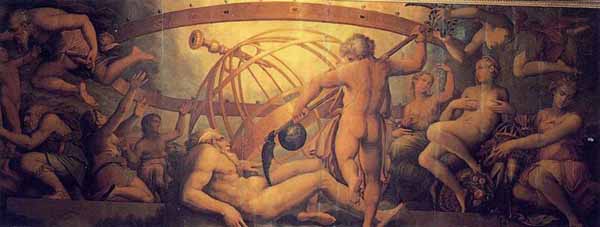This is a continuation of yesterday’s Part I. I have repaired some typos and unmangled some syntax in the original article.
We can learn a great deal about the effect of the opposition between these two planets by looking back to the post. Back in the fall of 1917 Saturn in Leo began a series of oppositions to Uranus in Aquarius, and halfway through the cycle Uranus entered Pisces followed by Saturn’s entry into Virgo to mirror the opposition that is beginning in November. World War I was already in progress, having begun in June 1914 with the assassination of the Archduke Ferdinand in Austria-Hungary by a Serb nationalist, just two months after Pluto entered Cancer in April. Cancer of course is the sign of the homeland, and Pluto’s journey through Cancer witnessed a world war (Pluto) over national boundaries (Cancer) and the subsequent complete redrawing of the world map. These new national boundaries gave rise to cultural sensitivities (Cancer) that fostered the beginnings of World War II as Pluto left Cancer for Gemini.
Putting the Saturn/Uranus opposition in the context of the greater Cancerian dynamic, the most interesting timing coincidences of this period is the Balfour declaration which establishes a home (Pluto in Cancer) in Palestine for the Jewish people and the Bolshevik revolution in Russia just as Uranus and Saturn aligned in opposition. The Old and the New, battling for supremacy. During this period too, women (Cancer) all over the world won the right (Uranus) to vote and to become a part of the political process (Saturn)
It wasn’t until 1920 that Uranus had moved into Pisces and was opposed by Saturn in Virgo. At that time the Russian Civil War had turned the liberation (Uranus) of the Bolshevik revolution into the repressive regime (Saturn) of the Soviet Union. The Irish fought a war of independence (Uranus) that was brutally quashed by the British (Saturn).
In the battle between Saturn and Uranus, it is difficult to predict who will be the winner. Often there is a dialectical process in which a successful Uranian rebellion brings a period of Uranian chaos which is then followed by a Saturnian repression in order to consolidate order, but the old way of doing things has been irrevocably changed.
The next Saturn/Uranus opposition occurred in the spring of 1964, this time with Saturn in Pisces and Uranus in Virgo. This effects of this opposition are inextricably woven in with the conjunction of Uranus to Pluto that occurred at the same time, so the pressure for conformity of Saturn was battling not only with Uranus but also with the powerful climactic urge of Pluto for change and transformation. This was a period of unprecedented cultural rebellion and revolution: so-called “free love” and open marriage, revolutionary ideas in psychology and psychiatry, Black Power and the civil rights movement, Women’s Liberation and the battle for female equality. The Beatles and the British Invasion, and Chubby Checker brought black music into the homes of middle class white folks for the first time.
It is said that the easiest way to tell a liberal from a conservative is to ask them about the 60s. If they say “it was a great time,” they’re a liberal. If they say “it was horrible,” they’re conservative. The liberal mind loves change and easily embraces new ideas (Uranus). The conservative mind abhors change and seeks security and stability (Saturn). This is the underlying dynamic in the opposition between these two planets.
So what is in store for us over the next two years? Tune in tomorrow for what I promise will be the last installment of this series!

